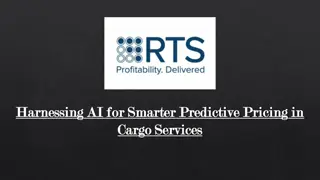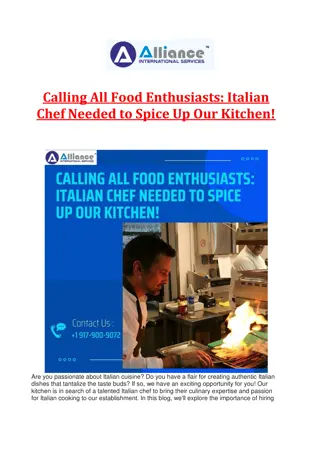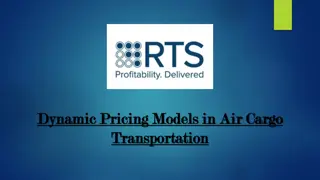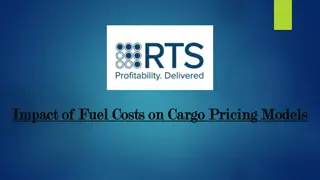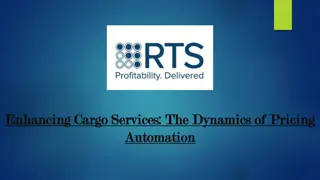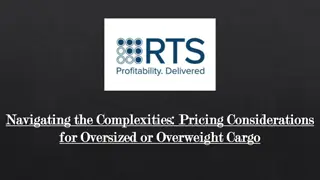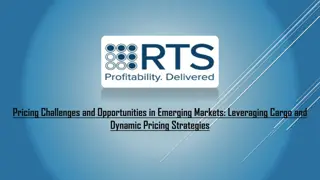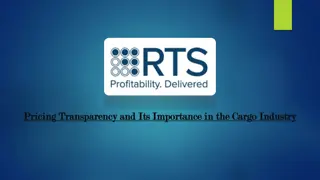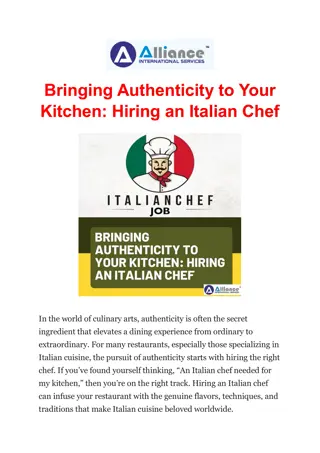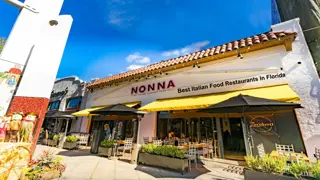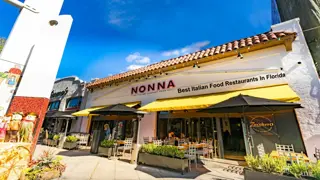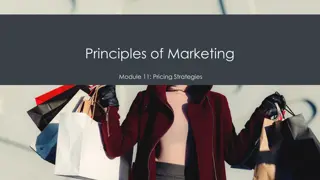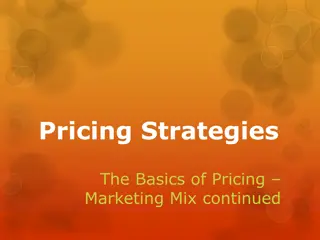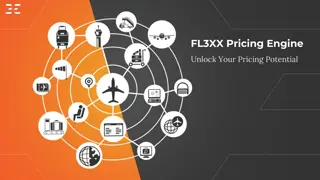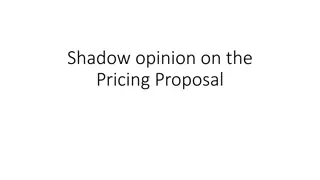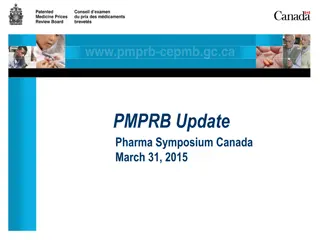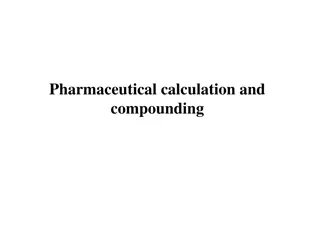Excessive Pricing in Pharmaceutical Markets: The Italian Experience
The presentation by Andrea Pezzoli explores the issue of excessive pricing in pharmaceutical markets, focusing on the Italian experience. It covers cases of infringement on excessive prices, such as the Aspen pharmaceutical group's fine for unfair pricing. The regulatory framework in Italy, including the negotiation process between pharmaceutical companies and the Pharma agency, is also discussed. The presentation sheds light on the challenges and implications of pricing practices in the pharmaceutical industry.
Download Presentation

Please find below an Image/Link to download the presentation.
The content on the website is provided AS IS for your information and personal use only. It may not be sold, licensed, or shared on other websites without obtaining consent from the author. Download presentation by click this link. If you encounter any issues during the download, it is possible that the publisher has removed the file from their server.
E N D
Presentation Transcript
EXCESSIVE PRICING IN PHARMACEUTICAL MARKETS: THE ITALIAN EXPERIENCE Andrea Pezzoli AGCM Director General for Competition OECD COMPETITION OPEN DAY PARIS, 27 FEBRUARY 2019 1 The opinion expressed in this presentation are personal and they do not necessarily reflect those of the AGCM
Preliminary remarks Non confidential
Preliminary remarks PREVIOUSLY ON . EXCESSIVE PRICING IN ITALY: Very few decisions of infringement on excessive prices (one concerning airlines, where the benchmarks were both the pricing behavior of a non-dominant competitor and the costs of an efficient player, and two on airport handling services where the benchmark was directly provided by the sectorial regulator). A306 Veraldi/Alitalia (airlines), 2001 NO SUFFICIENT EVIDENCE A376 ADR/tariffe aeroportuali (handling Rome), 2008 VIOLATION OF ART. 102 A 377 SEA/tariffe aeroportuali (handling Milan), 2008 VIOLATON OF ART.102 Key aspect of these cases: Super-dominance Lack of regulation or inaction of the regulator Clear benchmark for prices Non confidential
1. ASPEN: the proceedings On 29 September 2016 the ICA fined Aspen pharmaceutical group for the infringement of Article 102, lett. a), TFEU for unfair pricing The case concerned a portfolio of antineoplastic drugs that Aspen had bought from GSK in 2009 (the Cosmo Package). The Authority began its investigation in 2014 after a consumer association (and media reports) had claimed that the National Health System (NHS) was experiencing shortages in the provision of the cancer drugs. long-off patent but still used in the treatment of severe blood cancers prices entirely reimbursed by the NHS (so called A class drugs) prices applied in 2013 date back to the time of first marketing authorization ( 50s and 60s) no entry by generics given the small size of the markets and the fact that entry costs may exceed expected profits. In March 2014 Aspen, at the end of a negotiation with the pharma regulator (AIFA), had obtained substantial price increases for those drugs: The prices charged by Aspen were deemed excessive after a careful analysis performed using several tests. Aspen threatened leaving the Italian market if the Pharma agency (AIFA) did not accept the price increases. Non confidential
2.The regulatory framework The Italian NHS grants total reimbursement for drugs that are deemed essential for the patients. The price of these drugs is defined through a negotiation process between the pharmaceutical companies and the Pharma agency (AIFA). The revision of an approved price (renegotiation) is admitted, under condition of the companies proving a documented change in production costs. But if no agreement is reached with the pharmaceutical company, the drugs would be automatically moved in the class C, on charge of the patients. At the end of 2013 ASPEN submitted to AIFA an initial request for reclassification of the Cosmos drugs from the so called Aclass (price for the patient totally reimbursed by NHS) to the Cclass (where the companies are free to set the price and drugs are not reimbursed). AIFA rejected the request for reclassification, considering the drugs essential (lack of therapeutic alternative for certain categories of patients). In October 2013 ASPEN and AIFA entered into a negotiation for new reimbursement prices for Cosmos drugs since the price applied in 2013 dated back to the time of the first marketing authorization ( 60s). In March 2014 the negotiation ended with AIFA s approval of new A class prices for Cosmos drugs, accepting the prices increase submitted by Aspen. The outcome of the negotiation was influenced by the threat, advanced by Aspen, of leaving the Italian market if the regulator did not accept the price increases. Non confidential
2.The regulatory framework AIFA, the Italian Pharma agency ( theregulator ) is just a negotiator and has no power to impose prices in case of disagreement Non confidential
3. Market Definition The ICA defined four relevant product markets at ATC5 level (molecule level): markets of drugs based on the active ingredients mercaptopurine, tioguanine, melphalan and chlorambucile. The decision was based on the absence of therapeutic alternatives to Cosmos drugs in Italy for specific groups of patients in specific phases of their illness. Other authorized drugs for the treatment of the same pathologies (based on different active ingredients) were not considered substitutable, because of their formulation for infusion (hospital use) while Cosmos products are available in tablets and used for home therapy; The independent experts contacted by ICA affirm that they are therapeutically irreplaceable and Aspen experts confirmed that there are no alternative products for specific diseases and for the frailest patients (children and elderly). Non confidential
4. Dominance Lack of effective competition: Aspen the only supplier in each of the relevant markets. Lack of potential competition: - No patent barriers but lack of incentive to entry: the scarce sales volume at the new prices ( [5-10] mil ) reduces the incentives to enter in the markets (risk to not recover the entry costs); - no entry of generics. Asymmetric bilateral monopoly where the supplier has higher bargaining power (the Pharma agency has no power to impose price, needs to keep the drugs in Italy as a drug reimbursed by the NHS and without the agreement, the drugs would be automatically included in the class on charge of the patients; inelastic demand for life saving drugs. Non confidential
5. The conduct EXCESSIVE PRICING The infringement of 102.a TFEU consists in the imposition of excessive and unfair prices, through the adoption of a negotiating strategy: Aspen threatened discontinuing the supply of the drugs on the Italian market if the increases were not approved. the ICA reinforced its analysis by using two different measures of the excess of prices: combination of different methods. This is in line with European case law, which favours the application of more than one method of analysis, in order to - reinforce conclusions; - avoid false positives . Non confidential
6. Excessive pricing test FIRST METHOD: gross margin The ICA calculated the difference between ex ante Prices and Direct Costs. The resulting Gross Margin in % of sales was compared to the Total Indirect Costs in % of sales to conclude that: 1) prices before the increase already granted a margin in line with Aspen average. 2) therefore, price increase % ranging between 300% and 1500% of initial prices conducted to an unreasonable excess of prices on the economic value. Non confidential
7. Excessive pricing test SECOND METHOD: cost plus The ICA calculated the difference between prices and a comprehensive measure of costs called cost plus - including direct costs + a portion of indirect costs + a reasonable rate of Return On Sales (a quite generous 13%...CMA based it assessment in the Flynn Pharma case on a ROS of 6%...). The analysis allowed to conclude that prices applied by Aspen: 1) generate excess in % of cost plus ranging from 100% to almost 400%. 1) these % are well above those which have been considered abusive in previous cases (e.g., deutsche post: 25%; albion water ii: 46%). Non confidential
8. Excessive pricing test The excess ranges from around 100% to almost 400%, depending on the assumptions on the rate of return granted in the calculation (13%, the average ROS of the sector, or [15- 20]%, the specific Aspen group ROS) and the inclusion of the trademarks purchase: ROS 13%: excess between [100-150]% and [350-400]%. ROS 13%+trademarks: excess between [100-150]% and [300-350]%. ROS [15-20]% : excess between [100-150]% and [250-300]%. ROS [15-20]%+trademarks : excess between [50-100]% and [200-250]%. Non confidential
8. Excessive pricing test Supplementary benchmarking: intertemporal comparison of prices - increases between 300% and 1500% - not necessary (generating losses or very low margins) - previous prices already covering direct costs Non confidential
9. Unfairness absence of any economic justifications for such an increase: - no increase in production or distribution costs documented by Aspen; - no need to recover innovation investments; absence of any non-cost related factor leading to an improvement in quality or in the level of service to the NHS or patients; the nature of the drugs and characteristics of Aspen -no patent coverage -no R&D expenditure Non confidential
8. Excessive pricing test Actual prices were significantly (up to 1500%) and persistently above the benchmark prices (AIFA, the Italian Pharma agency, was forced to approve the prices increase) Non confidential
9. Unfairness absence of any economic justifications for such an increase: - no increase in production or distribution costs documented by Aspen; - no need to recover innovation investments; absence of any non-cost related factor leading to an improvement in quality or in the level of service to the NHS or patients; the nature of the drugs and characteristics of Aspen - life-saving drugs - no patent coverage - no R&D expenditure Non confidential
10. Negotiation Strategy STRATEGIC PRESSURE ON THE REGULATOR Aspen adopted a comprehensive strategy to put pressure on the Pharma Agency (AIFA): strategic request for drug reclassification from A class to C class: Aspen was aware of AIFA s impossibility to accept (essential medicines for the treatment of cancers); threat of withdrawing the drugs from the Italian market, if AIFA did not accept the proposed prices; artificial scarcity in the Italian distribution system: a shortage of its drugs in the Italian distribution system was observed despite the absence of any production problems: according to the ICA, this artificial shortage, generated through Aspen Europe-wide stock allocation mechanism, was aimed at influencing AIFA decision making process Non confidential
11. Injunction Cease and desist order (September 2016): Aspen had to stop its abusive conduct and inform the Authority, by 60 days after the decision, of the action adopted to comply. The Decision did not tell Aspen what prices to set and how to set them. Aspen has to charge prices which have a reasonable relationship with the economic value of the products. It is for Aspen to charge prices which are compatible with EU and Italian competition law. ICA did not act as a price regulator). Aspen request for interim measures (rejected in February 2017 by the First Instance Tribunal) Aspen appeal of final decision (rejected in July 2017) Non confidential
12. Non-Compliance InMarch 2017 the ICA opened the non-compliance proceedings March-June 2017, interim agreement between AIFA and ASPEN: retroactive reimbursement to the NHS of half of the difference between the 2013 prices and the 2014 ( unfair ) prices June 2017 - February 2018, unsuccessful negotiation between Aspen and AIFA rejected Aspen request to: include trademark acquisition costs among the production costs relevant to justified the price increase; use EU weighted average prices rather than 2013 prices as a starting point for the negotiation; use the prices of therapeutic alternatives as benchmark. In March 2018, the ICA sends a Statement of Objections (SO) to Aspen, alleging a dilatory strategy by refusing to provide relevant information (i.e., contracts signed with the actual drugs producers) Non confidential
13. Happy Ending: New Negotiated Prices In April 2018, after the SO, Aspen submitted all the relevant information (supplier contracts, costs related to quality & safety etc.) and reached an agreement with AIFA PUBLIC PRICES* in March 2014 (Unfair) Prices % 2013 Prices 19 April 2018 Prices 2014-2018 - 5.8 95.1 19.24 116.68 156.39 33.62 17.34 80% -53% -29% -65% -82% ALKERAN TABLETS 69.21 53.99 16.82 7.5 247.35 219.44 95.1 94.95 ALKERAN INJECTION TIOGUANINA PURINETHOL LEUKERAN June 2018: the ICA closed proceedings with no sanctions the application of the new prices is retroactive, to the date of the infringement decision (September 2016) Estimated public savings: roughly 8m per year, on the basis of the public prices net of legal discounts and selective reductions Non confidential
CONCLUDING REMARKS Wahl s opinion provides a useful framework for the assessment The specific characteristics of the Aspen case fit the criteria suggested by Wahl, even those more complex concerning the fairness test Legal tests useful but little help from the economic theory The practical results of the ICA s intervention were quite successful In this perspective the Aspen case confirms that CAs intervention on excessive prices should be exceptional but cannot be excluded if we believe that - without abandoning the consumer welfare standard - CAs should not ignore the increasing request of fairness coming from the society The regulatory gap and the empowerment of the Pharma agency. The ICA is monitoring the process 21
THANK YOU! ANDREA.PEZZOLI@AGCM.IT 22



